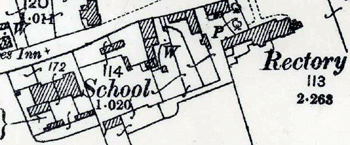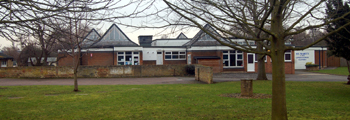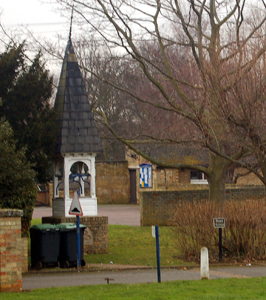Clophill School
![Clophill Schools about 1900 [Z1130/31/34]](/CommunityHistories/Clophill/ClophillImages/Clophill Schools about 1900 [Z1130-31-34].jpg)
Clophill Schools about 1900 [Z1130/31/34]
Clophill was awarded a grant to build a National School between 1834 and 1838. They received £50 for a school to accommodate 110 children. The parish records [P45/29/2] contain a conveyance of 5th August 1836 by Thomas Philip, Earl de Grey to the curate and trustees on a piece of ground adjoining the road from Shefford containing 10 poles on which the schoolhouse was to be built "…for the purpose of educating boys, being children of the poorer classes of the inhabitants in Clophill and neighbourhood, in the principles of the United Church of England and Ireland upon such a system as the patron, rector and curate shall appoint". The parish records also contain plans and elevations of the new school [P45/29/3]. A report was compiled by the School Inspector on Bedfordshire, Huntingdonshire and Cambridgeshire Church Schools in 1844 and he reported that Clophill school "taught 3 days in the week chiefly by the Clergyman".
Notes on events in the parish from the back of a parish register [P45/1/4] record:
- 1835: New School Room built for the Boys [presumably the National School].
- 1837: Writing School for Boys three times a week established [as noted in the School Inspector's report].
- 1842: Anniversary Sermons for Girls School by Rev. F. Clutterbuck on August 14th.
- 1843: Anniversary Sermon for the Girls School on July 30th by Rev. E. L. Sayer.
- 1844: June 16th: Girls Sunday School anniversary 45th preached by the Rector, Collection £23.
- July 1847: 48th Anniversary Sermon on behalf of the GirlsSchool - Rev. B. Trapp preached.
The parish archive [P45] contains a considerable number of lists of children at the schools. There are lists for the boys from 1856 to 1903 [P45/29/510] and girls from 1862 to 1903 [P45/29/11-15].
An enquiry was made by the Church of England in 1846/7 as to all its church schools. This was against the background of a new Whig government which championed secular education and the increasing importance of nonconformists, particularly Wesleyan Methodist, and Roman Catholics in providing schools. The parson reported that there was a Sunday school with 100 boys and 100 girls. A Daily school taught writing and was attended by 24 boys and 36 girls. There were four Daily Dames’ schools which taught 40 boys and 24 girls. The return recorded that: "The want here is not so much of masters to teach, as of good will in the parents in sending their children to school for instruction. The parents send them to work at straw-plaiting at an early age. The schools are chiefly supported by Lady de Grey and the Rector". The parish register [P45/1/4] records for 1853: "A daily school was established at Clophill and Mr. Austen a journeyman from Campton was engaged at a Salary of £40 per annum".
The first Education Act was passed in 1870 (more correctly it was known as the Elementary Education Act). It was a milestone in the provision of education in Britain demonstrating central government's unequivocal support for education of all classes across the country. It also sought to secularise education by allowing the creation of School Boards. These were groups of representatives, elected by the local ratepayers and the Board had the powers to raise funds to form a local rate to support local education, build and run schools, pay the fees of the poorest children, make local school attendance compulsory between the ages of 5 and 13 and could even support local church schools, though in practice they replaced them, turning them into Board run schools (known as Board Schools). Naturally, and luckily for local historians, the Act required a questionnaire of local schools in 1870. In Clophill it was felt that no efficient school existed; accommodation was needed for 140 boys and 92 infants. In the return there were details of a proposed scheme for building schools in Clophill for 250 children which would provide all the accommodation required.
A remedy for this state of affairs was not long in coming. In applying to the Lords of the Committee of Council on Education for a grant for the new school on 14th July 1870 [P45/29/25] the reasons for a new school were given as follows:
- That the existing school house does not come up at all to the present requirements of Government either with regard to site or arrangements.
- That there is no proper school for girls in the Parish.
- That the distance to the nearest school (nearly two miles) is too great for it to meet the wants of this Parish.
- That the Parish is of such a size that it ought to possess efficient schools of its own.
The parish records contain a conveyance [P45/25/22] of 4 May 1871 from the rector, with consent of the bishop and patron of the living, to trustees of 1 rood 20 poles adjoining the rectory garden for school buildings to be erected upon as well as plans and elevations [P45/29/23-24]. Clophill National School was opened by a short service on Friday 5th January 1872. After the open air service there was a service in Church and a sermon was preached on behalf of the school by the Rev Hugh Ross, the collection amounting to £7 15s 6d. [Micf 38/15]
Children often missed school because they were needed to help at home or with work as these extracts from the school logbooks show [Micf 38/15]: 23rd June 1893: "some children have been irregular [this week] owing to their mothers going out and gathering peas or fruit and the children kept at home to mind the house and baby"; 6th October 1879: "owing to the harvest being so backward this year another week’s holiday was given to enable the children to go gleaning". There were treats too: 6th April 1894: "yesterday the children of both Departments had tea together. In the evening the Rev G. Bosanquet exhibited a magic lantern much to the amusement of the children" [Micf 38/15].
The school had good inspection reports such as this one from 28th October 1879: "Singing good. Tone good. Considering the unusual length and lateness of the harvest holidays the exam was extremely good, and there is everywhere evidence of care and hard work". Children paid fees until the introduction of the Fee Grant in 1891. Before then they were sent by parents who often felt they could not afford it, sometimes children took the money and teachers were faced with the task of collecting it. 4th January 1886: "Sent E Grummitt home for his school money but he did not return. Therefore I cancelled his attendance".

The schools in 1901
A land mark Education Act was passed in 1902, coming into effect in 1903. It disbanded the School Boards and gave day to day running of education to newly formed Local Education Authorities, usually the county council, as in Bedfordshire. The old Board Schools thus became Council Schools whilst the old National, British and other non-Board schools became known as Public Elementary Schools. Clophill duly became a PublicElementary School.
![The schools about 1900 [Z50/31/60]](/CommunityHistories/Clophill/ClophillImages/The schools about 1900 [Z50-31-60].JPG)
The schools about 1900 [Z50/31/60]
Bedfordshire & Luton Archives & Records Service has a scrapbook of Inspector's reports for most Bedfordshire schools [E/IN1/1] for a period from just before World War One through the inter-war years. The inspectors reported separately on the infants and the junior mixed departments of the school. Thus in 1911 the infants department was reported to show "something of an improvement. The lowest class is brightly and well taught under great disadvantage owing to deficiency of floorspace". However, two years later the Inspector reported "The condition of the Infants' School is far from satisfactory. The Teaching is lacking in both intelligence and thoroughness: order is poor, prompting is extremely prevalent, and the children quite fail to make adequate progress. These remarks, however, do not apply to the lowest class. A very marked improvement will be looked for next year if the School is to be considered efficient". By 1921 it was reported "This School has greatly improved since the present Head Teacher took charge. The children are alert and interested in their work and the general condition of the School is now satisfactory. As good methods are used, further progress is likely".
The Inspector at the junior mixed school in 1911 found it "in good order and continues to be taught with considerable success". By 1913 things were rather less rosy, at least amongst the younger children, probably as a result of the problems with the InfantsSchool. This is borne out by the remarks of 1919 that "Considering that the children are in an extremely backward condition when admitted to this Department, a great deal of credit is due to the teacher of the lowest class for the progress they make while in her charge". The fruit garden attached to the school was considerably neglected and the Inspector considered that tending it should form part of School Gardening curriculum. The Inspector in 1923 reported that the Head Teacher was just about to retire, he felt that there was much about the school that was good but that certain weak points needed addressing "If the Head Teacher succeeds in putting these matters right he will leave the School in a very creditable condition".
The inspection of 1924 was confined to the premises and the numerous problems, perhaps most striking of which were, as usual, sanitary arrangements: "There are 44 girls and 54 infants at present. There is one door leading to four seats, not decently separated for both sexes. These were, apart from this, offensive on the day of the visit. There was no earth provided and the lighting and ventilation were not good. The boys' urinal is badly shaped and inadequate. They have three seats not in separate compartments: and otherwise bad. There is no provision at all for Teachers though there are five women assistants. The children's arrangements are so disgusting and so lacking in privacy that these Teachers cannot be expected to use them".
In 1925 it was reported: "The new Head Teacher's first year at this school has been attended by unfortunate circumstances. One member of Staff has been absent five or six months, another two months, and a third one month". It does not state whether the toilets were to blame. Despite this the school was doing well with P.E. quite the best in the area.
In 1927 the school and schoolhouse were valued under the 1925 Rating Valuation Act when the schoolhouse was reported as a brick and slate semi-detached house with a parlour, living room, kitchen, scullery and pantry downstairs and four bedrooms (one small) upstairs; outside were a barn and washhouse, earth closet, coal barn and garage. The school was noted as built for 233 with an average attendance in 1926 of 142 and 139 in 1927, outside it had a drying shed, coal shed, boys' and girls' lavatories and a wood shed.
In 1928 the Inspector opined that "This is a very good CountrySchool, conducted in inferior premises, on sound, and usually, progressive lines". By 1933 the headship has changed and it was reported of the new head "…although in some ways his general control could be tightened up somewhat, it is clear that he is anxious to make a success of his job". In 1938 The Inspector recorded that the day of the inspection was "unpropitious, as the children who were to have been moved to a new Senior School were all present because the new building was incomplete…In these circumstances the work…did not show up very well: but on previous occasions, and in the Term tests which have been preserved, much was found that was very praiseworthy, especially when the cramped conditions of the two small rooms are taken into consideration".
The third of the great Education Acts was that of 1944 which established the principle of County Primary Schools for children up to the age of 11, at which time they took an examination to determine the nature of the secondary school they would attend until they were 15, the most academically able going to grammar schools, the rest to secondary or secondary modern schools. The act also created two types of successor to the public elementary schools - the Voluntary Aided and Voluntary Controlled schools. Voluntary Aided schools are those in which the Local Education Authority funds the school but the governing body is independent, they are usually Anglican or Roman Catholic schools. Voluntary Controlled schools own their own buildings whilst the staff are employed directly by the governors. Clophill became a Voluntary Controlled County Primary School.

Saint Mary's Lower School February 2010
In the 1970s Bedfordshire County Council introduced comprehensive education, doing away with the 11+ examination and grammar schools and introducing a tier of school between the old CountyPrimary and CountySecondary Schools. Thus Lower Schools now taught children aged 4 to 9, Middle Schools from 9 to 13 and UpperSchools from 13 onwards. Clophill became a VoluntaryControlledLowerSchool for pupils aged 5 to 9 in 1975 and moved to a new building in 1976 in the High Street. On 1st April 2009, Bedfordshire County Council having been abolished the new Local Education Authority of Central Bedfordshire became responsible for Clophill.
 Remains of the former Saint Mary's School February 2010
Remains of the former Saint Mary's School February 2010